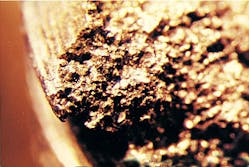F. Elshawesh, E. Elagdel, A. Elhoud
Petroleum Research Center
Tripoli, Libya
Intergranular fractures in the bolts that failed are seen in this macroscopic photograph (20x; Fig. 1).Metallurgical analysis attributed bolt failure of several oil well submersible pumps to a problem with quality control during the manufacturing process of the bolts.
The Monel K-400 flange bolts that failed connected the motor sections with the motor protectors.
The examined bolts were found to have different microstructures because of different manufacturing processes or quality control.
The bolt failure may be attributed to the grain coarseness and segregation of some elements in the grain boundaries caused by the heat treatment (overheating) during the manufacturing process (hot forging). Unlike the bolts that had not failed or were new, the bolts that failed had coarse-grained structure and low hardness.
Presence of H2S downhole may also have facilitated the failure.
The bolts failed after only 9 months of service in a high working temperature (150-200° C.), sour-crude environment.
Analysis
All the bolts were examined in detail to ascertain the cause of the failure.The bolts included:
- Failed bolts "connecting the lower part of the pump"
- Bolts without failure "connecting the upper part of the pump"
- New, unused, bolts manufactured by two different sources.
Microscopic examination
The microscopic examination, with a low-magnification microscope (up to 10x), looked at the fracture surfaces and surrounding areas of the failed bolts. The aim was to identify the fracture mode and any defect or corrosion attack on failed bolts.The examination showed the following:
- The fracture surfaces of the failed bolts were flat and lay about normal to the operative tensile stress axis. The fracture path was along the grain boundaries, as can be seen in Fig. 1.
- The external surface of the failed bolts showed no scratches, notches, or sign of corrosion attack, as can be seen in Fig. 2 [38,441 bytes].
Metallurgical examination
The metallurgy of the three classes of bolts was examined to identify any microstructural differences existing between them. The results were as follows:- The failed bolts (longitudinal and transverse cross-sections) showed a coarse (large) grain, as seen in Fig. 3 [29,718 bytes]. This type of microstructure may have occurred during the manufacturing processes (hot forging process). Overheating during this process may be the prime cause that led to grain coarseness in the microstructure of the failed bolts.
- The microstructure examination (transverse sections) at the vicinity of the fracture surface showed numerous intergranular cracks (Fig. 4) [15,950 bytes]. This result confirmed the finding that the bolts connecting the lower pump section failed along the grain boundaries.
- The bolts without failure revealed fine microstructure (fine-grain size microstructure), compared to the failed ones (Fig. 5) [32,691 bytes]. However, in some areas, the microstructure showed coarse grains, also as shown in Fig. 5. This indicates that the manufacturing process was not properly controlled, such as in the preheating prior to the final shaping.
- For comparison, the unused bolts that were obtained from stock showed a fine-grained microstructure (Fig. 6) [32,635 bytes].
Hardness measurement
Table 1 [34,356 bytes] shows the bolt hardness measurements. It indicates that that the failed bolts had the lowest hardness readings compared to the other bolts. This is consistent with the metallurgical result where the microstructure was found to have a coarse-grain structure.These results show that the failed bolts have low mechanical properties (hardness and tensile strength). Therefore, these bolts were unsuitable for the downhole pump application that requires high-strength bolts.
Uncontrolled preheat treatment during the manufacturing processes (hot forging) probably caused these low mechanical properties.
Chemical composition
A chemical analysis was also performed on samples from the three classes of bolts.Table 2 [15,775 bytes] shows that all bolts have the same chemical composition and met the requirements.
Bolt failure
Both microscopic and metallurgical examinations revealed that the bolts failed along the grain boundaries. This type of fracture mode usually is observed in the following three circumstances:- The bolts may fracture intergranularly (along the grain boundaries) at temperatures ranging from room temperature to 150° C. The bolt grain boundaries are embrittled as a result of segregation of specific elements such as (O, S, C, N, or P) or precipitation of a second phase, such as carbides or intermetallics, in the grain boundaries.
These may take place because of uncontrolled heat treatment of the bolts prior to the forging (manufacturing) process.
- The bolts under tension may fracture along the grain boundaries when exposed to high temperature for a considerable time (creep). This alternative cannot be expected because of the low working temperature (150-200° C.)
- The bolts may fracture along the grain boundaries when enough hydrogen is generated from (H2S) precipitated at the grain boundaries (such as sour crude). The hydrogen at grain boundaries causes weakening, hence, grain separation (fracturing).
During pump operation, the weak bolts (coarse grained and weak grain boundaries) will be subjected to stress above their capacity, hence, failure along the weakest region in the microstructure, which is the grain boundaries.
The sour, H2S environment may have facilitated the premature breakage of bolts and pumps failure.
The Authors
F. Elshawesh is senior engineer and head of the corrosion group in the Petroleum Research Center, Tripoli, Libya. He has 11 years of experience in failure analysis for the oil and gas sector. Elshawesh has a BS in materials science from Alfateh University, and a PhD in materials science from Leeds University.
E. Elagdel is a junior corrosion engineer at the Petroleum Research Center, Tripoli, Libya. She has 5 years of experience in failure analysis and hydrogen embrittlement. Elagdal has a BS in materiel science from Alfateh University.
A. Elhoud is a junior corrosion engineer at the Petroleum Research Center, Tripoli, Libya. His areas of interest are failure analysis, hydrogen embrittlement of steel, and pitting corrosion of stainless steel. Elhoud has a BS in metallurgical engineering from Alfateh University.
Copyright 1999 Oil & Gas Journal. All Rights Reserved.






